Faces on the Wall
Here is where my lady, "Waiting In New Orleans" hangs. I call it our wall of faces. There are a lot of other things displayed as well, but the majority contains faces either in a composition or a sculpture. One of the faces is my first African piece.
There are a lot of other things displayed as well, but the majority contains faces either in a composition or a sculpture. One of the faces is my first African piece.
 Mask - 10"x12"- 1999
Mask - 10"x12"- 1999It began as an experiment in David Walker's class at Arrowmont that year. Attaching a border to quilts made in his reverse applique technique is a challenge.I thought there had to be a way to construct the mat/border and center of a piece all in one step.
This piece has five layers ... two exposed in the border and two in the center plus a backing. I drew the separate areas of the piece including the narrow inner border and the stitching lines on freezer paper. At this point each small section is designated a fabric role (as in fabric A is #1, fabric B is #2, etc. to #4.). The paper is ironed on the top layer and it's all pinned basted together.
For this applique technique all the lines are machine top-stitched, then areas are cut away down to different levels to expose a desired fabric. The freezer paper is left in place until it's time to cut in that spot.
This piece has five layers ... two exposed in the border and two in the center plus a backing. I drew the separate areas of the piece including the narrow inner border and the stitching lines on freezer paper. At this point each small section is designated a fabric role (as in fabric A is #1, fabric B is #2, etc. to #4.). The paper is ironed on the top layer and it's all pinned basted together.
For this applique technique all the lines are machine top-stitched, then areas are cut away down to different levels to expose a desired fabric. The freezer paper is left in place until it's time to cut in that spot.
 Black chenille yarn is couched over the seams of the center section and on each side of the inner border. The inner border is one straight cut through the top three layers and then brushed to make fabric chenille. A tan variegated 6-ply floss is couched with a variegated thread over the seams in the border.
Black chenille yarn is couched over the seams of the center section and on each side of the inner border. The inner border is one straight cut through the top three layers and then brushed to make fabric chenille. A tan variegated 6-ply floss is couched with a variegated thread over the seams in the border.The mask is hand appliqued and decorated with beads and brass washers. The binding incorporates pieces that were trimmed away from the center.
David's reverse applique technique in his work is amazing. Complex compositions are made much more easily than in any other way. At first, I felt "blind". There's no moving things around on a design board. I developed a great appreciation for, and trust in serendipity that week in March of 1999.
*All photos are clickable for you to view a larger version in a separate window. Click the back arrow icon of your server to get back to this post.
*The red highlighted text is also clickable to take you to the link or posting that is being referenced.




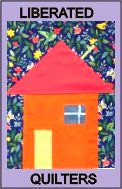 Fabric Bird Sculpture Pattern
Fabric Bird Sculpture Pattern




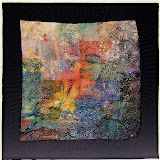
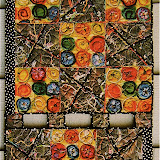
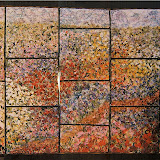
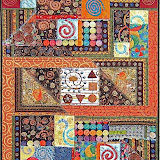
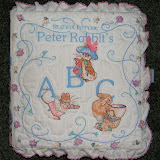
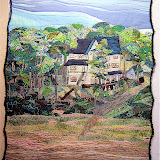
3 comments:
THat is an interesting way of doing borders. I may give it a try on my next piece if I can keep it small enough. THey keep growing. I love the couched yarn. Itgive such definition. I have pinned my city and am looking for quilting ideas. Couching around some of the buildings might work. Or at least between the city and the border.
I've decided that every time I like one of your quilts I will write in Italian..QUESTO E' FANTASTICO! (this is fantastic!). Thank you very much for your explanations..it seems quite easy..we'll see! ciao, ciao.
How wonderful to see you wall of faces, and this piece too. By coincidence, I am thinking about doing a piece of reverse applique according to a class I took from Libby Lehman last year. Like you, I'm bothered by not being able to audition. But it occurred to me this morning that I could cut the design from paper making a window and then see what the underneath shape would look like. Couldn't do that with anything as complex as yours though of course.
Post a Comment